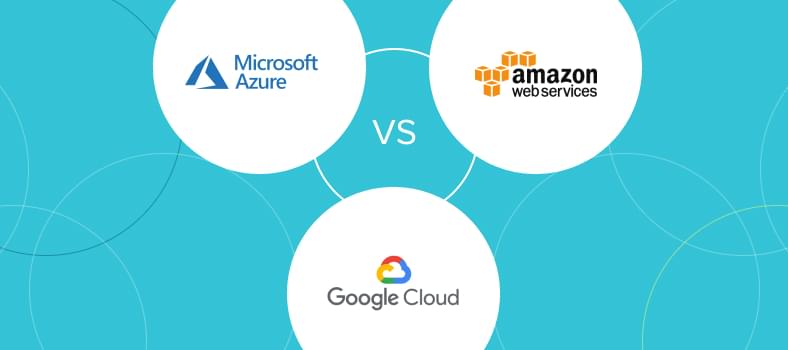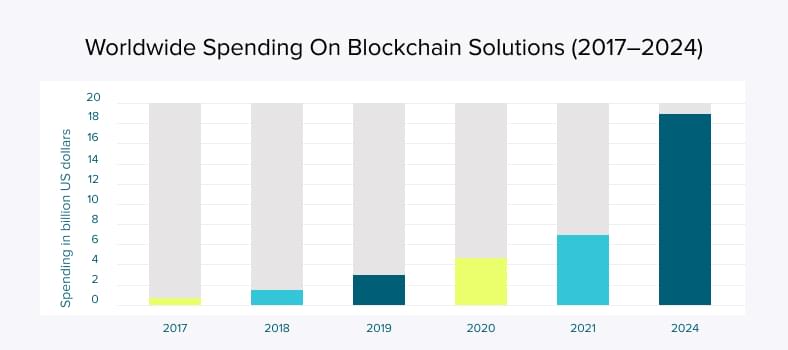In the face of digitalization and the pandemic’s impact on business workflows, the investment industry’s focus has shifted to online platforms. They allow wealth to grow, and customers understand it. In Australia alone, the investment platform market was US$680 billion in the first half of 2020, with positive growth of 8 percent in the quarter. This trend is global and clear for fintech companies and startups. Today, competing platforms...
It seems there’s no limit to software development growth and progress – and it’s not surprising. Markets and industries change every year, and so do customer needs. The world is never the same.
You’d probably ask ‘What should I do with it?’ The answer is simple – keep up with the trends. Or at least be aware of them.
Our today’s article aims to cover the hottest software industry trends that are worth your attention. We’re giving a rough idea of how software development will look in 2024. No crystal balls – only professional insights.
1. Fintech: OpenFin
Fintech is moving at the highest pace, numbering 26,346 companies globally in November 2021. In comparison, there were only 20,925 fintechs in 2020 (Statista). While the market is growing, existing and emerging businesses require a common infrastructure – OpenFin is a decent response to this.
OpenFin is a company founded in 2010 that provides a desktop operating system for financial organizations of different types and sizes. As of 2021, the platform is used by 2400 companies with 300,000+ users in total.
The core of this OS is Google’s Chromium and GitHub’s Electron. The idea behind OpenFin is to align and standardize solutions for capital markets enabling companies to faster build and deploy new digital products for their needs. Moreover, these products are interoperable and thoroughly protected.
OpenFin is a system added to your existing tech infrastructure providing it with advanced features. Importantly, OpenFin does not host your app on its servers – on the contrary, software development teams have full control over the development process.
OpenFin was an “invisible” instrument before the notification center update – it goes with a visual interface, created specifically for the industry needs. For instance, some notifications can appear and then disappear, but some of them should remain on the screen until some action is taken.

As of now, OpenFin offers two groups of products:
- Workspace is an advanced management toolset that includes a range of features for effective working processes (Notification Center is one of them).
- Container is a platform for developers that allows building intuitive web apps using OpenFin APIs.
The platform offers fast and smooth digital transformation to any financial institution:
- Development companies get a powerful engine to build modern web apps for fintech,
- End-users enjoy an intuitive interface that eliminates repetitive tasks and integrates into the existing workflow,
- Separate businesses and the whole financial sphere have an opportunity to adapt to market changes faster than ever before.
2. Cloud Computing: AWS, Azure, and GCP
Migrating to the cloud is not among new software trends – it’s been on the market for some time now. Regardless of the company’s size and purposes, more and more businesses opt for cloud computing, and this tendency won’t go anywhere soon.
According to Statista, the global public cloud computing market is growing and expected to reach 482 billion USD next year.

Why are we mentioning AWS (Amazon Web Services), Microsoft Azure, and GCP (Google Cloud Platform)? These providers are among the industry leaders with a reputation of over 10 years.
As of 2021, AWS controls 32% of the public cloud market, Microsoft goes next with 21%, and GCP has 8% of the market (Statista).
There are numerous use cases for cloud migration. Organizations implement it for machine learning and artificial intelligence, data analytics, web and mobile app migration, etc.
Why should you consider cloud computing for your business in 2022? The answer is in its benefits:
- Cost-effectiveness. Just think about it: you don’t need special hardware to store organizational data and, subsequently, there’s no need to hire personnel for hardware support. Cloud service providers do the dirty work and save your operational costs.
- Scalability. Cloud services are adaptive to your business needs. You can expand the data storage at any moment, while buying additional hardware can be a matter of days or weeks. Additionally, you can cut off your cloud storage just as fast, which is hardly manageable with an on-premise server.
- Reduced time to market. Cloud computing allows for quick app deployment and, as a result, faster product delivery to the market. It’s an investment into a more efficient workflow.
- Fewer chances of data losses. The possibility of losing a piece of data in the cloud is barely possible because of regular backups. In case of a force majeure, you can always roll back to your latest update and restore the data infrastructure.
- Easy way to implement CI/CD. All the mentioned cloud platforms allow you to make automatic software deployment from various repositories and platforms like GitHub, Atlassian BitBucket, GitLab, etc. Additionally, using the IaC paradigm (Infrastructure as Code) allows you to automatize the scaling of your solution without app developers or SysOps (who do that manually).
3. Distributed Computing
Distributed computing is a technique of connecting several computer servers into one group to easily share data and manage processing power.

It’s no secret that data volumes are growing globally, creating challenges for application workload. Distributed computing helps to smooth it out through scaling. If you need more information to store, you only have to add another server to the group.
The next chapter of this story is distributed cloud computing. Cloud service platforms themselves don’t provide distributed computing by default, but you can find a lot of distributed computing software on the market that runs on the cloud. Furthermore, Gartner states that by 2024 most cloud service providers will enable distributed cloud computing.
Just as it is for cloud computing in general, businesses do not need to hire database administrators to manage the workflow. Now companies cooperate with cloud vendors responsible for the whole working process (including storage extension and security).
Industries that will benefit the most from distributed cloud computing in 2024:
- Fintech. The distributed cloud guarantees two critical aspects for financial institutions: low latency and fast transaction processing. Without these two factors, organizations won’t keep up with the competition.
- IoT and AI-powered software. Low latency comes in handy for these niches because they require real-time data delivered in seconds.
- Critical infrastructure facilities. Such organizations consider data security and stability as the key priorities. Distributed clouds are the optimal solution to control corporate data and reduce negative outcomes after a force majeure.
4. Low-Code and No-Code Development
Building from scratch or buying a ready-made solution? In some cases, you won’t have to make this choice thanks to LC/NC (Low Code/No Code), one of the top trends in software development.
Low code and no code allow you to create digital products with no advanced coding skills. Both tech- and non-tech specialists can benefit from it.
As the name suggests, no code is the simpler of the two. Imagine a drag-and-drop tool to create basic apps – this is a no-code platform in a nutshell. Solutions built with its help are not scalable or easily integrated with other tools, but they can be a go-to option in case of urgency or scope limitations.
Low code is more complex being in-between no-code and traditional development approaches. It has the same constructor principle as no code, but a future app can be customized through coding. It significantly increases the development speed as there is no need to write the basic code.
Common LC/NC applications:
- Transactional systems;
- Automating minor repetitive tasks that were previously accomplished by humans;
- Descriptive analytics and elements of predictive analytics;
- Website development;
- Automating marketing activities (email marketing or ad trafficking);
- Software configuration.
Examples of low-code platforms include LANSA, Retool, Shopify, Creatio, Creator (by Zoho), and others.
This trend is an investment savior for small businesses. Big enterprises will continue creating complex custom solutions, but startups that don’t have enough budget can choose a faster and simpler option (at least, for now).
These figures only prove our thoughts. By 2030, the global low-code market is expected to get a 187 billion USD revenue (compared to 10.3 billion USD in 2019), moving at the pace of 31.1% CAGR. On top of that, 75% of IT leaders and 67% of developers state they can’t afford to miss the low-code trend.
5. Salesforce
For those who need some intro information, Salesforce is a company that offers a cloud-based CRM as the main product and offers tools for customer service, analytics, marketing activities, and application development.
If you visit the company’s website, you can get lost in the variety of products. Let’s take a look at some of them:
- Sales Cloud is a toolset to boost your sales activities. The features include contact management (for a tailored sales experience), sales forecasting, process automation, and so on.
- Service Cloud is an AI-powered customer service software. It allows your employees to provide personalized client support and increase loyalty and engagement.
- Marketing Cloud is robust marketing software for emails, digital advertising, analytics, and data management based on deep customer insights.
- Commerce Cloud is tailored for online shopping. It is powered by Salesforce CMS, enabling businesses to build up shopping navigation as quickly as possible.
- Tableau Analytics helps companies to manage valuable data smartly. With Tableau, you’ll monitor information in real time and be ready for possible changes.
Moreover, Salesforce acquired Slack at the end of 2020. It means that all of Salesforce products are enhanced with a well-known and reliable communication tool.
Salesforce has built such a massive product infrastructure that many IT specialists are willing to pass the Salesforce training and offer integration services to their clients.
As usual, figures will demonstrate it better:
- Salesforce revenue has reached 25 billion USD in 2021, which is a record number for the company;
- Another record is the Salesforce net income – over 4 billion USD this year. The previous net income peak was 1.11 billion USD in 2019 – four times lower than this year.
Salesforce is a winning combination of low-code cloud-based services. You don’t need to build up a custom CRM or similar solution (which is an unaffordable investment for startups and small businesses). Moreover, you can enjoy all the advantages of cloud-based solutions and their easy implementation.
6. Blockchain
There’s hardly anyone in the business world who hasn’t heard a thing about blockchain. Still, people usually connect it with cryptocurrencies (specifically Bitcoin). However, the niche has gone further. Smart contracts, security for logistics and supply chains, identity protection – all these features make blockchain one of the hottest software development technology trends.
Statista predicts that by the end of 2021, the blockchain market will reach 6.6 billion USD, and in the next three years, it will make a leap to 19 billion USD.

The popular blockchain use cases in 2021 include:
- IoT devices: while smart technologies become more advanced storing all the data in the cloud, blockchain is here to take care of the security standards. In 2019, Gartner published a report proving that. 75% of IoT adopters used blockchain or were planning to use it by the end of 2020.
- Artificial intelligence: both AI and blockchain industries can gain more advantages if mixed together. Thus, AI solutions obtain secure data sharing, decentralized computing, and coordination of untrusting devices. Blockchain solutions, in turn, get secure personalization and automated governance.
- Fraud prevention: blockchain is a decentralized ledger, meaning it’s a security-rich infrastructure to store and exchange data. Because of this core characteristic, blockchain has become a unique solution for fraud prevention in finance, supply chains, and identity management.
- Smart contracts: it is a document in the form of a coded line executed automatically when predefined conditions are met. It prevents numerous fraudulent activities that usually happen in traditional contracting by eliminating third parties and paper documents.
- Social media: blockchain is used to protect the client’s data within social media platforms. Examples include Streemit, Minds, and Sapien. The key advantage of these instances is the user’s full control over their privacy due to the advanced encryption of each interaction.
7. NFTs (Non-Fungible Tokens)
NFTs are digital objects that represent different collectible items sold online using cryptocurrencies and within blockchain’s smart contracts. Note that every NFT is a unique item (“non-fungible”), so a buyer acquires a special certificate proving the fact of ownership.
This phenomenon has been on the market since 2017 (the collection of “CryptoKitties”), but its finest hour has come in 2021. Originally, the tokens were Ethereum’s idea and existed only on that blockchain, but with time, other market players joined the race with their NFT versions.

While it seems irrational for many, the NFT market is now gaining momentum. In March 2021, the artist Beeple sold the token of his work for 69.3 million USD. As of today, around 40 000 tokens are sold daily with their trading volume of around 100 million USD.
We agree that non-fungible tokens are not exactly a software development trend, but it is surely one of the loudest digital trends at the moment. Also, it can potentially be a new revenue stream for individual entrepreneurs – many compare NFTs to digital art that you can own and then sell for a higher price.
Will this trend disappear any time soon? Probably not. The main reason for it is that many creators and big companies are joining the NFT movement.
For example, Kings Of Leon generated over 2 million USD selling their new album in the form of NFTs. Marvel is also in the game with its NFT collections featuring Spider-Man and Captain America. If your business is in the creative niche, you can generate an NFT collection yourself and make revenue through it.
Conclusion
There’s no way to predict for sure what new concepts in software development are waiting ahead. But we can suggest what trends will continue changing the digital world in 2024.
- OpenFin offers one system that fits the needs of the fintech industry. With its help, financial organizations can build and deploy interoperable apps faster than ever before;
- Cloud computing (including the distributed cloud model) is becoming more popular each year because of its cost-effectiveness, scalability, reduced time to market, and low chances of data losses;
- As the number of apps and websites grows exponentially, the digital world needs a solution to optimize the development process. The answer to this request is low-code/no-code development;
- Blockchain ensures the optimal level of security for numerous industries. Previously, it was used mostly by the financial sphere, but this tendency might change with AI, social media, logistics, and other niches starting to adopt the blockchain technology;
- With a net income of 4 billion USD, Salesforce is becoming one of the leading complex solutions for various business needs and, at the same time, one of the most promising trends in software development for 2024.

Polina is a curious writer who strongly believes in the power of quality content. She loves telling stories about trending innovations and making them understandable for the reader. Her favorite subjects include AI, AR, VR, IoT, design, and management.
